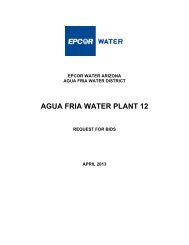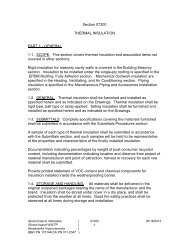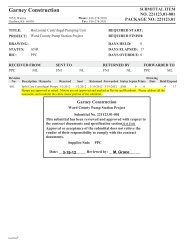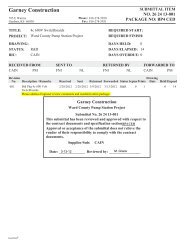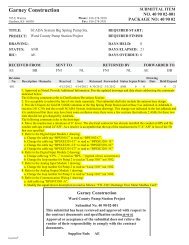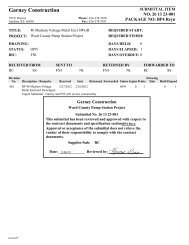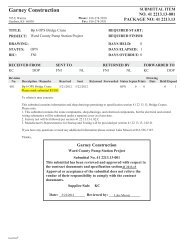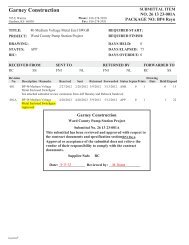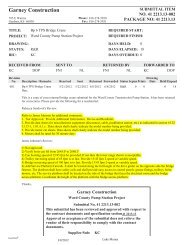33 12 16.26 - 001-A - Butterfly Valves - Garney Construction
33 12 16.26 - 001-A - Butterfly Valves - Garney Construction
33 12 16.26 - 001-A - Butterfly Valves - Garney Construction
You also want an ePaper? Increase the reach of your titles
YUMPU automatically turns print PDFs into web optimized ePapers that Google loves.
4<br />
Preparing Drive Bush<br />
7<br />
4.1 IQ10 to IQ35<br />
Thrust Base Types A and Z<br />
Removal of Drive Bush for<br />
Machining<br />
Fig. 4 Bronze Drive Bush Fitted into<br />
Thrust Taking Base<br />
Turn actuator onto its side, remove the<br />
two cap-headed screws holding base<br />
plate onto thrust base, pull out the<br />
drive bush complete with its bearing<br />
assembly.<br />
Before machining the drive bush the<br />
thrust bearing must be removed.<br />
IQ10, IQ<strong>12</strong> and IQ18 actuators have a<br />
sealed thrust bearing located on the<br />
drive bush and retained by the steel<br />
Fig. 4.1 Components of Type A<br />
Thrust Base<br />
bearing stop ring. The bearing stop ring<br />
is locked with one socket set screw.<br />
IQ20, IQ25 and IQ35 have a thrust race<br />
ball bearing within the steel bearing<br />
housing, located on the drive bush and<br />
retained by the steel bearing stop ring.<br />
The bearing is sealed within its housing<br />
by O-rings located on the drive bush<br />
and on the bearing stop ring. The<br />
bearing stop ring is locked with two<br />
socket set screws.<br />
1. Locate and loosen the locking socket<br />
set screw(s) in the bearing stop ring.<br />
2. Unscrew the bearing stop from the<br />
drive bush. Slide the bearing off the<br />
drive bush. Keep the drive bush and<br />
stop ring in a safe clean place.<br />
3. For all sizes ensure the drive bush<br />
male thread (stop ring) is not<br />
damaged during machining. For sizes<br />
IQ20, IQ25 & IQ35, ensure the O-ring<br />
located in the drive bush is not<br />
damaged during machining. Machine<br />
drive bush to suit the valve stem,<br />
allowing generous clearance on the<br />
screw thread for rising stem valves.<br />
Re-assembly<br />
1. Remove all swarf from the drive<br />
bush, ensuring the O rings on the<br />
drive bush and bearing stop ring<br />
(where fitted) are undamaged, clean<br />
and greased.<br />
2. Slide the bearing assembly onto the<br />
drive bush and ensure it is fitted<br />
down to the drive bush shoulder.<br />
3. Screw the stop ring with the locking<br />
socket set screw(s) uppermost on to<br />
the drive bush until it comes to a<br />
stop – hand tight and lock with the<br />
locking socket set screws. The<br />
locking socket set screws must be<br />
done up tight to prevent the<br />
assembly working loose, as shown in<br />
Fig 4.2. Refer to the table below for<br />
required tightening torques.<br />
Socket set Allen key Torque Torque<br />
screw size bit size Nm lbs/ft<br />
M4 M2 2.2 1.62<br />
M6 M3 7.8 5.75<br />
Fig. 4.2<br />
4. Refit the drive bush assembly into<br />
the base casting on the actuator,<br />
ensuring that the slots in the drive<br />
bush are located into the drive dogs<br />
of the hollow output shaft.<br />
5. Refit the base plate and secure with<br />
cap-headed screws.



